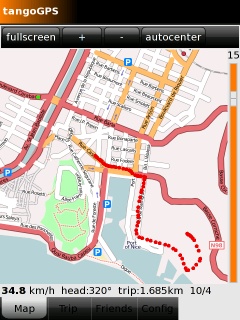TangoGPS
From Openmoko
| Languages: |
English • العربية • Български • Česky • Dansk • Deutsch • Esperanto • Eesti • Español • فارسی • Suomi • Français • עברית • Magyar • Italiano • 한국어 • Nederlands • Norsk (bokmål) • Polski • Português • Română • Русский • Svenska • Slovenčina • Українська • 中文(中国大陆) • 中文(台灣) • Euskara • Català |
TangoGPS is one of the applications that runs on the Openmoko Phones. For a list of all applications, visit Applications
Contents |
TangoGPS is a map application which can utilize Neo's built-in GPS to show your current location.
Website: http://www.tangogps.org
Running tangoGPS on Om 2008.8
| NOTE: There may be other steps because I remember it took a while before my TangoGPS started working, but these are the only things I remember installing |
From the freerunner connected to the internet:
opkg install gpsd opkg install http://www.tangogps.org/downloads/tangogps_0.9.3-r1_armv4t.ipk
If opkg complains about not being able to acquire a lock, try:
pkill packagekit
To get gpsd working on the Freerunner you have to change the configuration according to Gpsd#GPS_on_GTA02. Then start gpsd by:
/etc/init.d/gpsd start
Now you must power up the GPS-chip by opening the "Settings" application and setting the GPS entry to "on". Now you can run tangoGPS and wait until it get's a GPS fix. This can take up to a few minutes.
Running TangoGPS on debian
Tangogps is a very nice GPS mapping application. The latest version is available in Debian.
Unfortunately it depends on gpsd which conflicts with frameworkd in fso-frameworkd.
# apt-get install gpsd tangogps
Edit /etc/frameworkd.conf. In the section [ogpsd], edit to read:
# path = /dev/ttySAC1 path = /dev/null
/etc/init.d/fso-frameworkd restart /etc/init.d/zhone-session stop && sleep 2 && /etc/init.d/zhone-session start
# dpkg-reconfigure gpsd
- Start gpsd automatically on boot? Yes.
- Device the GPS receiver is attached to: /dev/ttySAC1
- Should gpsd handle attached USB GPS receivers automatically? Yes
- not certain what this answer should be
- Options to gpsd: none
Start tangogps like this:
# echo 1 >/sys/devices/platform/s3c2440-i2c/i2c-adapter/i2c-0/0-0073/neo1973-pm-gps.0/pwron
Turns the GPS on.
# DISPLAY=:0 tangogps
Issues:
- The different daemons for reading GPS data mean that both tangogps and the framework demo GPS application can't be configured to work at the same time. Reboots are probably necessary when switching between them.
- Both gpsd and the framework publish GPS data through dbus, though with different interfaces. This suggests a number of possible solutions.
- gpsd or the framework could implement the other's interface (along with their own).
- a translator could read one interface and emulate the other
- the framework could have an option to read data from gpsd.
- opgsd/gypsy could be extended to be backwards compatible with the majority of gps applications.
- Both gpsd and the framework publish GPS data through dbus, though with different interfaces. This suggests a number of possible solutions.
Downloading Maps for offline use
tangoGPS can bunch-download the map images so you don't need an internet connection while walking around. By default tangoGPS stores downloaded maps to /tmp/. This folder is lost every time you reboo the device. But you can use the "Config" tab within tangoGPS to change the "Cache Dir" location to , for example, /osm/ . So downloaded maps will be kept in the Neos flash, also after reboot. This works fine on OM2007.2 and Debian. If this config gets lost during reboot file a bug against your distro.
Once you have set the location to a non-volatile path, you can connect your Neo to the internet by USB or WiFi at home and start downloading the maps of your area. Tap the map screen and select "map download". Now on-the-road tangoGPS will be able to show you maps in different zoom levels even though you are not connected to the inet.
Downloading Maps via GPRS
I think TangoGPS may have started working after I followed the instructions to get GPRS working with GSM multiplexing here: Manually_using_GPRS#Option_1:_With_GSM_multiplexing_and_with_a_GUI
There are steps included in those instructions to improve GPS performance. The great thing is that once you get GPRS working, you can roam with TangoGPS running and have it download maps as needed over the GPRS connection!
Importing Tracks into TangoGPS
TangoGPS is able to record and store a track in its native format, and tools exist to convert this to GPX. However, TangoGPS does not support the import of tracks. You may help yourself by using this tool to import GPX trackpoints as a series of POIs directly into the sqlite database which tangoGPS uses to store POIs.
Using Google Maps with TangoGPS
Go to Config and change the url to http://mt1.google.com/mt?&x=%d&y=%d&zoom=%d and check the "Inverted Zoom" box. Press save Repository Configuration and you're ready to go.
- Automated map download will most certainly fail, as Google is very keen on keeping leechers out.
- It did work for me...

